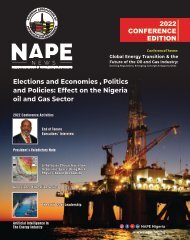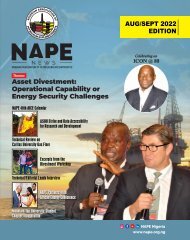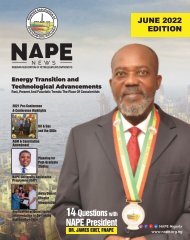NAPENews Magazine June 2023 Edition
NAPENews Magazine June 2023 Edition
NAPENews Magazine June 2023 Edition
You also want an ePaper? Increase the reach of your titles
YUMPU automatically turns print PDFs into web optimized ePapers that Google loves.
wavefields of high resolution when compared with ray-based<br />
methods and one-way wave equation-based methods. High<br />
resolution seismic data is a primary driver in exploration and<br />
development of complex subsurface structures to unlock hidden<br />
potentials.<br />
RTM gives higher accuracy than other less robust/cheaper<br />
methods for imaging of steep dips. RTM uses an adjoint operator,<br />
which is not the same as the inverse, thus amplitude problems are<br />
generated which can be solved by applying a least-squares scheme<br />
in the migration. Least-squares migration (LSM) can potentially<br />
reduce migration artifacts and improve lateral resolution (Liu et al.,<br />
2019). LSM uses iterative methods to match the observed data for<br />
every iteration and can solve the amplitude inaccuracy of RTM.<br />
Therefore, RTM can be implemented by a least-squares scheme,<br />
which is LSM (Yang et al., 2017).<br />
Reverse Time Least Squares Migration (RTLSM) is believed to<br />
generate superior images compared to conventional RTM and<br />
Kirchhoff imaging from a structural and amplitude perspective.<br />
Seismic imaging also suffers from illumination at targets based on<br />
focused energy. With the recent advances in industry scale<br />
RTLSM, improvements in this scheme helps to produce gathers<br />
and stacked images suitable for amplitude interpretation through<br />
preconditioning constraints which can reduce noise, migration<br />
swings and cross cutting noise that corrupt the reflector amplitudes<br />
(Duveneck et al., 2019; Chandran et al., 2019).<br />
LSM Theory: The theory of modelling recorded seismic data<br />
abounds in numerous literatures and publications. Here we attempt<br />
to reproduce the basic concepts from those existing materials.<br />
The forward modeling operator that relates the reflectivity model m<br />
to scattered seismic data d can be represented by<br />
d = Lm 1<br />
where, L represents the forward modeling operator. The migration<br />
operator is the adjoint of the forward modeling and can be<br />
represented by (Claerbout, 1992):<br />
mi = LTd 2<br />
where, mi is the migration image. Conventional RTM method,<br />
employ the adjoint modeling operator, by reversing the forward<br />
wave propagation effects from the data.<br />
For a better reflectivity image, the imaging problem can be<br />
represented as a least square inversion problem which requires the<br />
minimization of an objective function. LSM solution is obtained by<br />
minimizing the objective function S(m) which is the squared<br />
difference between the forward modelled data Lm and the recorded<br />
data d (Equation 1).<br />
The normal equation which is solved to obtain the optimal image is<br />
given in equation 4.<br />
LTLm = LTd 4<br />
In this equation LTL is the Hessian of the linearized modeling<br />
operator. LT is the imaging (migration) operator (adjoint of L) and L<br />
is the linearized modelling (demigration) operator (Duveneck,<br />
2021).<br />
Fig. 2: (A) shows a schematic diagram of how LSM works and (B) is Dong et al., 2012 workflow for implementation of LSM.<br />
The gradient is calculated by using conventional RTM with the data residual. The gradient is used to adjust the reflectivity<br />
model, the process iterates up to a certain level of residual.<br />
Basically, LSM applies the inverse of the Hessian matrix as the RTM adjoint operator (Wu et al., 2021). This application results in the<br />
removal of source signature blurring and uneven illumination producing an image with higher resolution and more balanced amplitude than<br />
the conventional RTM image. There are numerous proposed improvements for LSM (Dong et al., 2012; Huang et al., 2017; Wang et al.,<br />
2016).<br />
Advanced Imaging Solution: Due to time constraints, the denoised gathers and the migrated velocity from the immediate legacy<br />
processing was used as input into the more advanced seismic imaging solution – Reverse Time Least Squares Migration RTLSM. The<br />
implication here is that there was no new velocity model building done. Non iterative RTLSM was implemented for new stack volume and<br />
prestack gathers.<br />
One likely solution without this advanced high-end seismic imaging solution would have been to acquire new seismic data across the field<br />
and this comes with its attendant high-cost implication and minimal impact on the environment.<br />
NAPENEWS JUNE <strong>2023</strong> 17










